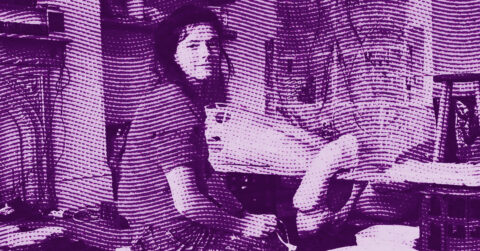Listen to me carefully, you bunch of snobs: while you are still gorging yourselves on your conceptual abstractions and your pretentious and boring installations, Daisy Dodd-Noble paints. She paints as one breathes, as one loves, as one dreams of a world where color could still save us from ourselves. And if you see nothing more than a comic strip landscape painting meant for lovers of pretty things, then you are missing the point. This woman does not do wall decoration: she performs true cosmetic surgery on our relationship with nature, with the precision of a neurosurgeon and the sensitivity of a poet.
Born in 1989 in London, Dodd-Noble belongs to that generation of artists who grew up amidst the climate emergency without succumbing to catastrophism. Graduated in 2016 from the prestigious New York Academy of Art, she was fortunate to attend the classes of Inka Essenhigh, that visionary painter who encouraged her students to paint from imagination rather than blindly copying photographs. This training proved decisive: where others merely reproduce the visible, Dodd-Noble invents possible worlds. Her landscapes are not open windows onto reality but portals to what the world could be if we finally accepted to look at it with the eyes of love rather than those of possession.
The artist does not hide her influences. She notably cites Lisa Yuskavage, that mistress of color who transforms light into pure emotion. This lineage is no coincidence: like Yuskavage, Dodd-Noble understands that color is not just an ornament but a language in its own right, capable of expressing what words cannot say. “There is something more intangible that we experience when looking at a tree or a flower in real life, or a work of art,” she confides. “It is this experience that interests me the most because I believe it transcends cultural boundaries” [1].
This quest for the intangible leads us directly to the heart of Bergsonian philosophy and its revolutionary concept of vital impetus. Henri Bergson, the thinker who revolutionized our understanding of life and evolution at the beginning of the 20th century, introduced the idea of an original creative force that continuously pushes life towards new and unpredictable forms. For Bergson, the élan vital is neither mechanical nor teleological but creative by essence, a perpetual generator of novelty [2]. This creative impulse, this “force creating in an unpredictable way ever more complex forms,” finds in Dodd-Noble’s work a particularly enlightening embodiment.
When the artist paints her trees in impossible colors, her candy pink forests or her emerald green volcanoes, she does not just play with chromatic codes: she materializes this Bergsonian energy that animates all life. Her landscapes vibrate with a vital force that seems to propel them out of the canvas. One finds here the “duration” dear to Bergson, that lived and subjective time that opposes the mechanical time of science. Each canvas by Dodd-Noble captures a moment of eternity, a moment where nature reveals its creative dimension. Bergsonian élan vital is no longer an abstract concept here but a tangible reality that strikes us full force through the expressive power of color.
This philosophical approach is coupled with a keen ecological awareness. Dodd-Noble does not paint nature as a backdrop but as a living organism endowed with its own intelligence. Her recent works on the tropical forest of Costa Rica reveal a profound understanding of mycorrhizal networks, those underground connections that allow trees to communicate and help each other. “The more time I spend in nature, the more I feel close to a universal truth about the interconnection of all life that goes beyond separation,” she explains [3]. This systemic vision of nature echoes the most recent scientific discoveries on the intelligence of forests, yet she translates it into a pictorial language of striking poetry.
Dodd-Noble’s technique fully embodies this aesthetic of vital impetus. Her layers of overlapping paint create multiple depths that seem to breathe before our eyes. She often works from direct observations of trees encountered during her walks, noting their “personality” or “particular energy” before transforming them into characters within her compositions. This method reveals an almost animistic approach to painting, where each natural element becomes a being endowed with consciousness and sensitivity.
The recent evolution of her work confirms this conceptual maturity. Her exhibitions “Truth of the Forest” at Massimo De Carlo in Paris in 2024 and “Grounded” at the L21 gallery in Palma de Mallorca in 2022 bear witness to a deep reflection on our relationship to biodiversity. The artist explores what she calls “the truth of the forest,” that timeless wisdom held by intact ecosystems that our technological civilization has largely forgotten.
But perhaps it is in her way of handling light that Dodd-Noble best reveals her uniqueness. Influenced by the masters of landscape painting, she develops a use of color that far exceeds mere imitation of reality. Her fluorescent orange skies, her purple grasses, or her electric blue trunks are neither fantasy nor gratuitous provocation. Rather, they express this energetic dimension of nature that our limited senses perceive only imperfectly. By freeing color from its representative function, Dodd-Noble gives us access to an augmented reality where nature finally unfolds in all its splendor.
This chromatic approach finds its roots in the most demanding contemporary art. The influence of Lisa Yuskavage is particularly felt in this sovereign mastery of color as a vehicle of emotion. Yuskavage, known for her Renaissance-inherited techniques and exceptional understanding of color relationships, has clearly passed on to Dodd-Noble this science of light that transforms each canvas into a total sensory experience [4]. Like her predecessor, Dodd-Noble understands that color can become an autonomous language, capable of communicating directly with our unconscious without passing through the filter of reason.
This artistic lineage sheds new light on the apparent simplicity of Dodd-Noble’s compositions. Behind her seemingly naive landscapes lies a technical sophistication inherited from the great masters. Her training at the New York Academy of Art gave her mastery of light relationships and space construction that distinguishes great painting from decorative illustration. Each coloristic effect is calculated, each harmony weighed, each contrast measured. This technical rigor allows emotion to express itself unhindered, freed from the clumsiness that often betrays amateurism.
Dodd-Noble’s ecological commitment thus does not stem from superficial activism but from a deep conviction nourished by an intimate understanding of the mechanisms of life. Her canvases function as silent manifestos in favor of a reconciliation between humanity and nature. By showing us impossible but desirable landscapes, she makes us aware of what we are losing. Her multicolored forests are not escapisms into a fantasy world but reminders of the infinite richness of a real world that our blindness condemns to disappear.
This political dimension of her work is expressed all the more powerfully because it carefully avoids direct preaching. Dodd-Noble does not paint ecological disaster; she paints threatened beauty. She does not denounce destruction; she celebrates creation. This positive approach reveals a remarkable strategic intelligence: rather than making the viewer feel guilty, she makes them want to protect what she shows them. Her paintings act like beneficial viruses that infect our vision and transform our relationship with the world.
The artist’s personal journey sheds light on this approach. A former oil industry employee in Dubai, she experienced the contradictions of our time from the inside. “It didn’t really seem like a choice,” she confides when recalling her artistic career change. “I was living in Dubai at the time, where there is wonderful contemporary art. I went to the Art Dubai fair and to some galleries in Al Quoz. Seeing all this extraordinary work made me want to create artworks like those artists” [5]. This late but decisive revelation perhaps explains the urgency that runs through her work. Dodd-Noble paints like someone who has lost time and intends to make up for it.
Her recent artist residencies testify to this quest for authenticity. Whether in Costa Rica to observe tropical forests or at Worlingham Hall in Suffolk, where a former hunting estate is being transformed into a natural sanctuary, the artist prioritizes direct immersion in the ecosystems she wishes to paint. This almost ethnographic approach feeds her compositions with a truth that imagination alone could not provide. Each canvas bears the trace of these encounters with living beings, those moments of grace where the artist and her subject commune in mutual understanding.
Institutional recognition logically accompanies this artistic maturity. The most demanding galleries, from Roman Road in London to L21 in Spain, passing through Kristin Hjellegjerde, regularly exhibit her works. The contemporary art market is beginning to acknowledge her value, as evidenced by auctions at Phillips and other prestigious houses. But this commercial success must not overshadow the essential: Dodd-Noble is one of those rare artists who manage to reconcile aesthetic rigor and accessibility, technical sophistication and direct emotion.
Her work fits into a glorious pictorial tradition while opening new paths for the art of tomorrow. Heir to romantic landscape painters and Fauvist colorists, she invents a visual language suited to the challenges of our time. Her canvases prove that it is still possible to believe in painting, in its capacity to transform our vision of the world and, thereby, the world itself. Faced with the environmental crisis and contemporary disenchantment, Dodd-Noble offers an artistic response of rare intelligence: rather than mourning paradise lost, she paints paradise to be found.
This forward-looking vision radically distinguishes her approach from that of her contemporaries. Where many get bogged down in nostalgia or pessimism, she invents possible worlds. Her impossible landscapes become programs for the future, invitations to reinvent our relationship to nature. By freeing color and form from their realistic constraints, she also frees our imagination from its destructive habits. Each canvas functions as a visual thought experiment, a laboratory where new ways of inhabiting the Earth are tested.
Bergsonian vital impetus thus finds a particularly fruitful actualization in Dodd-Noble’s work. This creative force that pushes life toward ever new forms is embodied here in an artistic practice that continually reinvents its own means. The artist does not content herself with repeating a successful formula: she constantly explores new chromatic territories, new compositional architectures, new ways to make abstraction and figuration dialogue.
This formal inventiveness is rooted in a deep understanding of the issues of our time. Dodd-Noble knows that art can no longer be content with merely being beautiful: it must also be necessary. Her paintings meet this requirement by offering an active, transformative beauty, carrying hope and change. They prove that aesthetics can still be political without sacrificing their sensual dimension.
This remarkable success places Dodd-Noble among the most promising artists of her generation. At 36 years old, she has already developed a recognizable plastic language and a coherent worldview. Her forthcoming creations will be closely watched by all who still believe in the transformative power of art. For beyond her purely pictorial qualities, Dodd-Noble’s work carries a message of hope that our time desperately needs.
In a world where nature seems condemned and contemporary art often wallows in irony or despair, Daisy Dodd-Noble chooses the path of active enchantment. Her paintings remind us that beauty is not a luxury but a necessity, that color can still save us, and that painting remains one of the last refuges of the human soul. For that alone, she deserves our attention and gratitude.
- Massimo De Carlo. “The Truth of the Forest, Daisy Dodd-Noble”. Exhibition press release, Paris, 2024.
- Bergson, Henri. Creative Evolution. Paris, Félix Alcan, 1907.
- Massimo De Carlo. “The Truth of the Forest, Daisy Dodd-Noble”. Exhibition press release, Paris, 2024.
- Yuskavage, Lisa. Lecture on colorist technique, quoted in GRAYSON, Emma. “Daisy Dodd-Noble Presents A Whimsical Environmentalism”. Art of Choice, February 29, 2020.
- Grayson, Emma. “Daisy Dodd-Noble Presents A Whimsical Environmentalism”. Art of Choice, February 29, 2020.
















